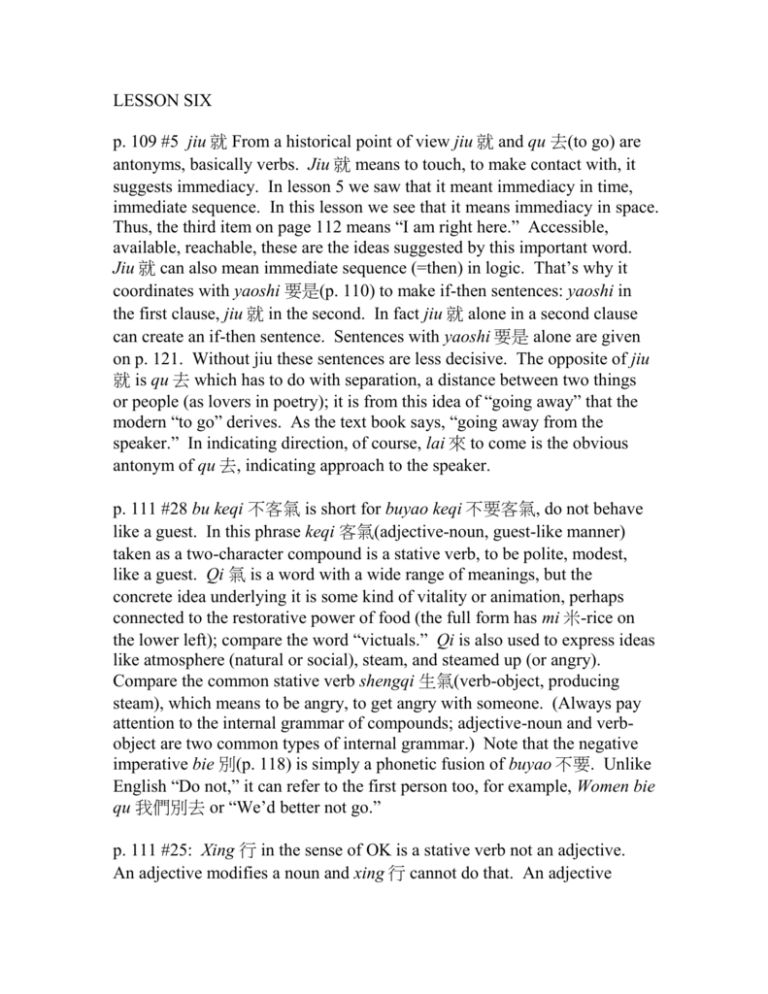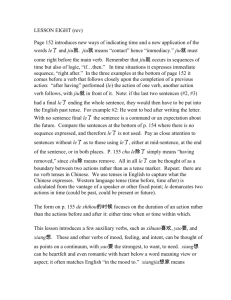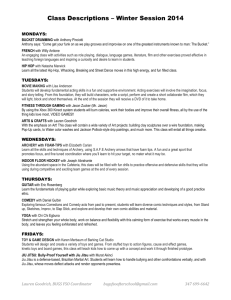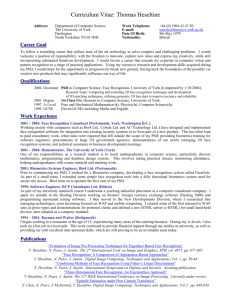Notes on Chinese Characters 6
advertisement

LESSON SIX p. 109 #5 jiu 就 From a historical point of view jiu 就 and qu 去(to go) are antonyms, basically verbs. Jiu 就 means to touch, to make contact with, it suggests immediacy. In lesson 5 we saw that it meant immediacy in time, immediate sequence. In this lesson we see that it means immediacy in space. Thus, the third item on page 112 means “I am right here.” Accessible, available, reachable, these are the ideas suggested by this important word. Jiu 就 can also mean immediate sequence (=then) in logic. That’s why it coordinates with yaoshi 要是(p. 110) to make if-then sentences: yaoshi in the first clause, jiu 就 in the second. In fact jiu 就 alone in a second clause can create an if-then sentence. Sentences with yaoshi 要是 alone are given on p. 121. Without jiu these sentences are less decisive. The opposite of jiu 就 is qu 去 which has to do with separation, a distance between two things or people (as lovers in poetry); it is from this idea of “going away” that the modern “to go” derives. As the text book says, “going away from the speaker.” In indicating direction, of course, lai 來 to come is the obvious antonym of qu 去, indicating approach to the speaker. p. 111 #28 bu keqi 不客氣 is short for buyao keqi 不要客氣, do not behave like a guest. In this phrase keqi 客氣(adjective-noun, guest-like manner) taken as a two-character compound is a stative verb, to be polite, modest, like a guest. Qi 氣 is a word with a wide range of meanings, but the concrete idea underlying it is some kind of vitality or animation, perhaps connected to the restorative power of food (the full form has mi 米-rice on the lower left); compare the word “victuals.” Qi is also used to express ideas like atmosphere (natural or social), steam, and steamed up (or angry). Compare the common stative verb shengqi 生氣(verb-object, producing steam), which means to be angry, to get angry with someone. (Always pay attention to the internal grammar of compounds; adjective-noun and verbobject are two common types of internal grammar.) Note that the negative imperative bie 別(p. 118) is simply a phonetic fusion of buyao 不要. Unlike English “Do not,” it can refer to the first person too, for example, Women bie qu 我們別去 or “We’d better not go.” p. 111 #25: Xing 行 in the sense of OK is a stative verb not an adjective. An adjective modifies a noun and xing 行 cannot do that. An adjective becomes a stative verb when it has a subject (explicit or implicit). The subject might be a noun or a noun phrase, for example, p. 112 bottom, “I’ll go to your office” is the subject of xing ma 行嗎? Logically, in English, this would be: Is it OK for me to come to your office? or My going to your office at 4:30, is that OK? p.110 #23: This is a new structure, often called the co-verb and verb structure. Dao is the coverb and it comes first; it has an object; the main verb is the second verb, in this case qu 去. Other common co-verbs are zai 在(to be at) and gei 給, (for, to <to give), on p. 109. For example, p. 122 #3 and #8. In #3 the main verb is da 打 , in #8 it is deng 等. This coordinated verb structure (verb-object and then VERB-OBJECT) is extremely common and should always be recognized. It is the core of many a Chinese sentence. The textbook calls the co-verb a preposition. In Chinese there are no true prepositions, simply verbs with a subordinate function. In English there are many prepositions; they float in the language as independent elements or they occur as prefixes of verbs to inflect the meaning. For example compare “induce,” “produce,” and “introduce,” three words built with prepositions upon the Latin stem duc meaning to lead (as in English duke). The absence of an active and diversified prepositional system in Chinese is one of the many barriers to interpretation and translation. p. 113 #4 zhongwen 中文, the Chinese language. There are a good many words for Chinese, and each has a slightly different emphasis. Zhongwen 中 文 is a modern word for the written language, but it can be stretched to cover the whole language. For spoken Chinese Zhongguo hua 中國話 is often used. Hua 話 means words spoken. The word wen 文, like qi 氣, is worth careful study, since it has so many functions in the language. One can get at some of the primary cultural concepts through these key words. They play a role in scores of compounds, and they have a long historical life.










